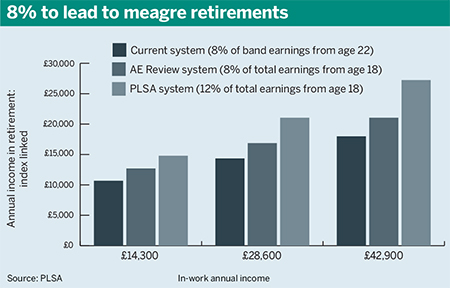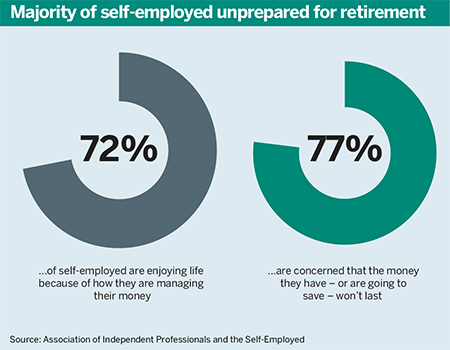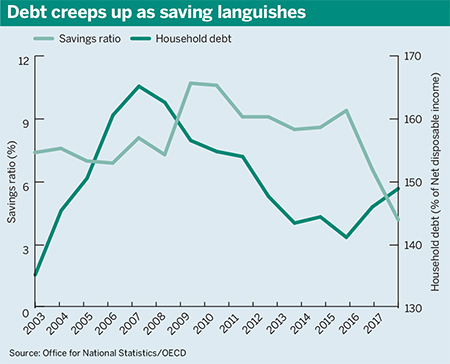Five defined contribution experts discuss whether the government should raise minimum contribution levels further than currently planned, and how to help low earners and the self-employed.

Auto-enrolment minimums are set to hit 8 per cent of pensionable salary next year. Should further increases be put in place?
Olivia Davis: The 8 per cent level in place from next year is not likely to generate the levels of retirement income that most people will need.
According to our analysis, average earners will need to save consistently at 12 to 15 per cent of salary in order to retire in their late 60s with a two-thirds of final salary replacement rate, taking account of state pension.
The auto-enrolment minimum contribution rates should be raised over the next few years to at least 10 per cent, and ideally 12 per cent, in line with the Pensions and Lifetime Savings Association’s Hitting the Target analysis.
Higher earners will need to save more to reach desired replacement rates, but this should be achieved by engagement and education rather than changing the default minimums for all.
Natanje Holt: It is widely accepted that 8 per cent is not a sufficient contribution rate to create a comfortable retirement savings pot for the majority of people.
The auto-enrolment journey has just begun and getting to an 8 per cent minimum contribution should only represent the first few steps towards a sustainable and suitable pensions framework in the UK.
Significant behavioural research trials have been conducted on methods to successfully increase rates, with limited or no friction from savers.
The industry and government should agree on one or more of these approaches and a timeframe to roll it out, helping people move towards a higher contribution rate.
The agreed approach could encourage people looking to opt out to reduce their contribution for a period rather than opting out, while an automatic facility could be triggered to move them towards the higher rate.
Naomi L’Estrange: Clearly we need higher savings levels than the minimums to create the right outcomes.
However at these levels we already create real questions around the interaction with means-tested benefits in retirement and whether saving is the right thing for groups of employees.
My feeling is, with the looming shadow of Brexit, we need to pause and look at providing the right incentives for employers and employees to save more without soft compulsion, perhaps in a more sophisticated way.
This could be done by encouraging staff to put increased salary straight into their savings, or by communications around the dashboard. Now does not feel the right time to announce a hike.
Mark Jaffray: A step up to 8 per cent is welcomed as a positive step to improve the amount of money in and outcomes. However, we know that 8 per cent still is not enough.
The PLSA recently reported that an 8 per cent contribution rate is likely to mean that 51 per cent of savers (13.6m people) are unlikely to meet the Pension Commission’s target replacement rate for median earners of just under £20,000 a year.
Instead of this, a stepped increase to 10 per cent and 12 per cent would be good in order to limit the immediate impact of costs of higher contribution rates to individuals and businesses.
Perhaps more immediately worrying is the number of self-employed people in the UK not being forced to contribute to a pension; over 5m people. Maybe we should focus on them?
Darren Philp: Auto-enrolment has made a great start in getting more people saving for their futures. And we know that in a DC environment it is all about contributing and contributing early.
We know that 8 per cent is not really 8 per cent, and we know it will not be enough for most people, especially if they start saving later in life. But it will be enough for some, particularly those on the living wage, where the state pension will do a fair share of the heavy lifting.
So there is a balance to be struck when thinking about increasing contributions. What I would like to see is the abolition of band earnings sooner rather than later so all contributions count. This was a conclusion of the auto-enrolment review, but has not yet been put into force, and we should get on with it.
Core contributions should then be increased to somewhere between 12 and 15 per cent. But we need to make sure there is the right balance between employer and employee contributions, and that people are not presented with an ‘all or nothing’ choice – maybe default people in at 12-15 per cent, but allow them to make an active choice to opt down to 8 per cent, rather than simply opt out? Three year re-enrolment could then be used to return contributions to the maximum.
We also need to think creatively about the types of savings that people have. Maybe it is too much to ask people to contribute up to 15 per cent of their salary and keep it all locked away until retirement.
Concepts like workplace ISAs and sidecar savings could help deliver more flexibility and give increased confidence to help people save.
With worrying levels of permanent millennial indebtedness, how should policy adapt to protect broader financial wellbeing?
Jaffray: For many young people with debts attracting interest at relatively high rates, saving for retirement may seem financially illogical.
Why save and earn, say 5-6 per cent each year in returns, when debt is costing you more than 10 per cent a year?
Pensions policy could respond by allowing some flexibility to convert pension contributions (perhaps even those from auto-enrolment) to be used to pay off debt.
Some employers do allow pension contributions to be taken as cash for a part of their contribution or for a temporary period in order to allow people to pay off debt. That seems like a sensible idea.
However, it is important to strike a balance. Some employers offering full flexibility in this way have found that employees find it difficult to increase saving again once they have got used to the additional ‘cash’ coming from their pension contributions.
Longer-term, this is not great, as diverting money away from individuals’ pensions will make it harder for them to generate good retirement outcomes.

L’Estrange: I think this is a bigger question than just pensions. In terms of the hierarchy of needs, young people clearly need to prioritise shelter and food before pensions or other saving; but waiting until they can sensibly afford to save will store up huge problems for the future. This may be ducking the question, but I think we need to solve the housing crisis first.
Davis: Saving for retirement needs to be part of a wider program of financial planning.
Sidecar accounts of accessible savings that sit alongside retirement savings accounts have a role to play in improving financial resilience especially for lower earners.
Saving for a house purchase deposit will be a priority for many, but there is value in getting in the habit of saving for retirement too.
With longevity increasing, and the expectation that people will work for longer, we will increasingly see the emergence of multi-stage lives.
In a multi-stage life, people may change career path and therefore there will be more need for retraining.
This will require some flexible access to savings in a way that is not currently provided for by pensions.
Philp: I think the clue here is in the wording of the question. For me it is not only about pensions policy per se, and as an industry it is important that we begin thinking about financial wellbeing as a whole and thinking about the future challenges that society will face.
The way in which people live their lives has changed significantly over the past 50 years, and we are now on the cusp of the fourth industrial revolution, which will fundamentally change the way we live, work and interact with each other.
So as an industry we should stop thinking about pensions as being special and start thinking about how we can best foster a culture of long-term saving.
For the industry this means providing products that the consumer needs and that fit in with the way people live their lives.
It is about providing integrated complementary products that meet people’s financial needs, it is not about thinking about any form of saving in isolation.
It is about having powerful defaults that mean that if people are not engaging then they are doing the right thing. And then it is about supporting people through life choices and giving them the tools and guidance to help them plan and understand the trade-offs they face.
Digital platforms, big data, and artificial intelligence provide the building blocks to allow companies and providers to have a new type of conversation with their customers.
By harnessing this, and by giving people the tools to more effectively manage and plan their lives, we will change our financial culture and focus on financial wellbeing. And that will be good for everyone.
Holt: The individual’s wider financial wellbeing has got to be considered to ensure policies work towards improving short, medium and longer-term financial health through savings.
The Nest sidecar study creates the foundation for a vitally important component of overall financial wellbeing.
Meanwhile the Resolution Foundation suggested a £10,000 payment to each young person and to change the inheritance tax approach to be a lifetime receipt tax, which should warrant wider consideration.
These type of social policies would make a significant difference helping the younger generation to counter the numerous social and economic headwinds that they face.
The recession and economic landscape has resulted in them earning less compared with their previous cohort for a longer period of time. The larger barriers to getting on the property ladder have not helped and neither has the political instability of Brexit.
How can we solve the self-employed problem in pensions?
Philp: The undisputed success of auto-enrolment in nudging firms towards offering a pension has been a game changer for those in employment, but it also widens the pensions gap between the increasing numbers of self-employed and those who now might enjoy employer contributions to their retirement savings plan.
Smart Pension has been investigating how to solve the savings conundrum for the self-employed for some time.
One solution for so-called gig economy workers might be by creating a simple system that would allow self-employed individuals who work or contract with a number of employers either at once or over time, to join their employer’s auto-enrolment scheme, and then aggregate these pots using the infrastructure that will be developed through the pensions dashboard.
In a nutshell, this could mean companies like Uber and those in the gig economy would be required to add contracted workers to their auto-enrolment scheme and pay contributions to that scheme alongside the self-employed worker’s own savings.
There are other options of course, and making this system work would implicitly increase the need for visibility and the ability to track and trace pots, and therefore would require the pensions dashboard to exist.
But the overriding message is that there are practical measures to help self-employed workers save for retirement.
Buried in the Autmun Budget was a plan for yet another consultation into the self-employed, this time focusing on their retirement savings.
A recent report from the Association of Independent Professionals and the Self-Employed suggested the self-employed would simply opt out of any auto-enrolment-style offering. So the publication of this paper may shed some light on the subject.

Holt: The self-employed’s lack of saving is unlikely to be addressed through a single initiative or policy. There are far too many categories of self-employment and reasons why people are self-employed.
In an effort to improve the savings available to the self-employed, numerous different solutions should be trialled to evaluate the outcome and to help develop broader solutions.
Technology is disrupting the way we work and how we earn. The pensions industry and government will need to become more agile to adapt to the changing needs of society, which means pensions as we know it might also need to change.
L’Estrange: This is a similar issue to the previous question. Many self-employed are low earners and the same problems arise, such as balancing the need to save, secure housing and avoid debt.
One could look at preferential tax treatment for business owners contingent on a certain level of saving, or rolling profits into a savings vehicle.
Davis: There is no easy solution to this, and self-employment takes a number of different forms, each with its own challenges.
Technology may help by creating apps and other tools that make it easier for the self-employed to save and that can accommodate the variable earnings that many self-employed people experience.
Collecting contributions through the tax system could offer a potentially efficient mechanism, although there seems to be political reluctance to do so.
But the issue remains that most people need a strong nudge to start saving early enough, and ultimately we should be looking at some kind of ‘opt out’ system rather than one driven by active engagement.

Jaffray: Only a small proportion of self-employed people currently contribute to a pension, a number that has declined recently to around one in five.
The self-employed should be brought into the auto-enrolment regime – why not apply the same framework to them?
However, a gradual increase in contributions would be essential, considering that a self-employed individual is fulfilling the role of the employee and employer, leaving them with the total contribution responsibility.














